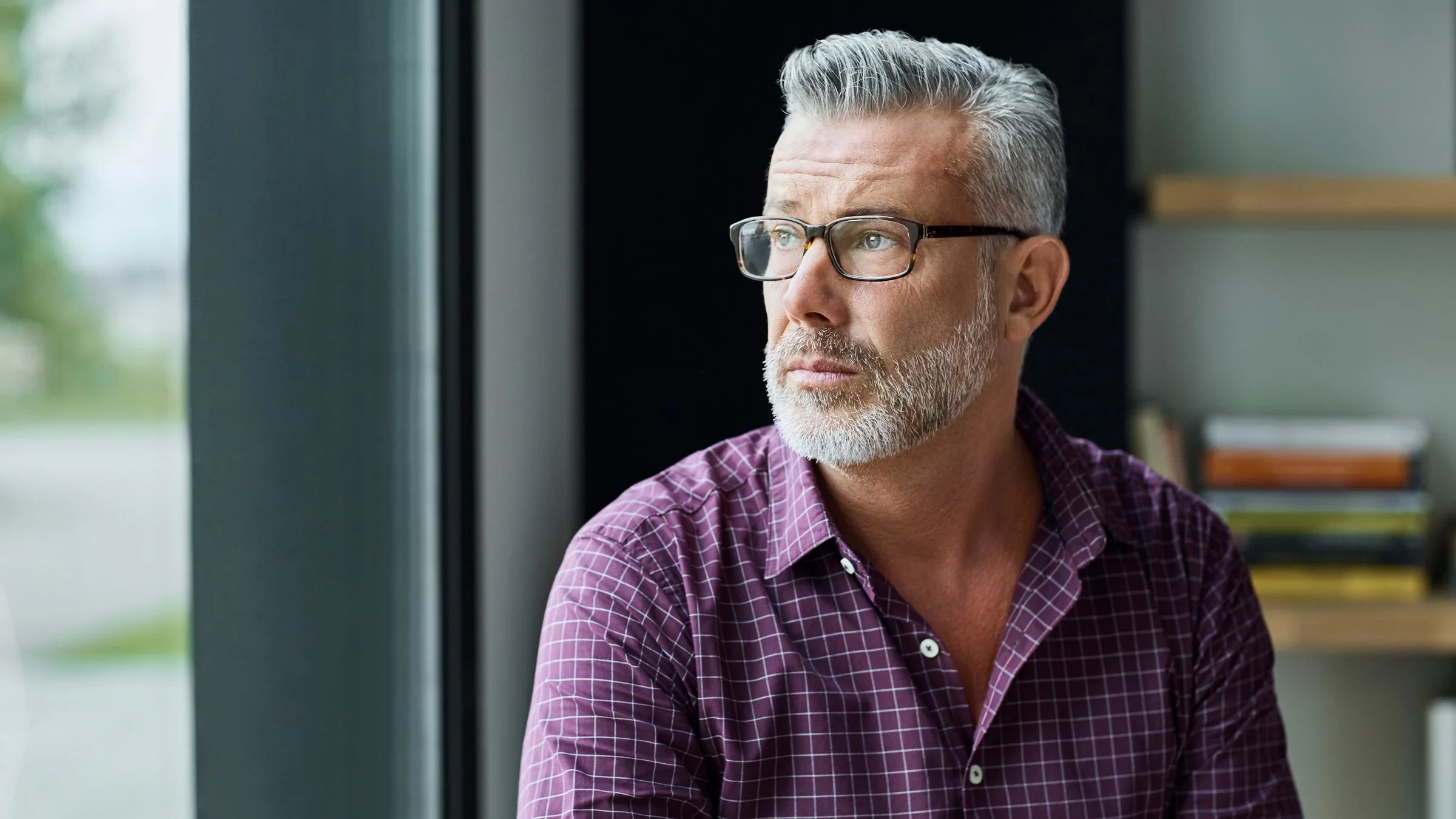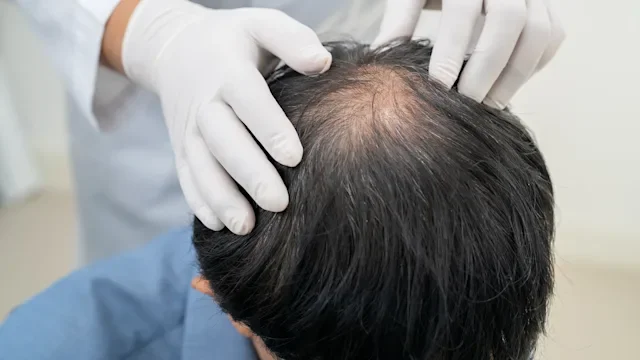Key takeaways:
Andropause or “male menopause” is a group of symptoms seen in an aging male with low testosterone. Symptoms include decreased sex drive, erectile dysfunction, weight gain, and many others.
Testosterone is the main male hormone associated with andropause. But other hormones and chronic conditions like diabetes may also be involved.
Treatment for andropause symptoms may include exercising, quitting smoking, and managing underlying conditions. Sometimes sexual symptoms are treated with testosterone replacement.
Most consider menopause to be a natural stage for an aging woman. The concept of “male menopause” is a bit controversial, but men can have age-related body changes, too.
Andropause is a group of symptoms that are frequently seen with a low testosterone level in an aging male. But unlike female menopause, andropause is not a normal part of the male reproductive cycle. So not all men develop symptoms. Those who have andropause symptoms typically have some other chronic condition as well.
Do men go through menopause?
Not exactly. Menopause is the end of the female reproductive period due to a decrease in hormones. This happens naturally and abruptly around the age of 50 when the menstrual cycle stops. Men tend to undergo a slower and less dramatic drop in hormones as they age, but some men can have an abnormal drop in testosterone and symptoms of andropause.
About 1 in 200 men experience this drop and symptoms of andropause. The average age of symptom onset is 51 to 60 years old. While it can occur, andropause is not considered a routine part of the aging process.
Andropause has been called “male menopause.” But that’s not entirely accurate. The term menopause refers to the end of the menstrual cycle, and those a male reproductive system don’t experience that. Andropause is the more appropriate term to use for the symptoms.
What are the symptoms of male menopause?
The symptoms of andropause are similar to those of female menopause. But they usually happen over time, unlike menopause symptoms, which occur suddenly.
Signs and symptoms that people report most often include:
Decreased sex drive and lack of desire
Erectile dysfunction (inability to have and keep an erection)
Brain fog (trouble concentrating)
Lack of energy or fatigue
Depression
Loss of muscle
Increased body fat
Decrease in body hair (especially on the legs)
Progressive decrease in bone density (osteopenia, osteoporosis)
Increase in fat around the internal organs
Do men get hot flashes?
Most men don’t get hot flashes with male menopause. That’s because the decline in testosterone is usually gradual. But certain conditions and treatments that cause a sudden drop in testosterone may lead to hot flashes. For example, some types of chemotherapy for prostate cancer can block testosterone’s effect and cause men to have hot flashes.
Read more like this
Explore these related articles, suggested for readers like you.
If you’re experiencing night sweats or hot flashes, don’t assume it’s related to aging. You should discuss these symptoms with your healthcare provider to determine the cause.
What causes andropause?
The exact cause of andropause is unknown. It is clear that as men age, their level of testosterone decreases steadily. Anyone with a male reproductive system who has a significant drop in testosterone can have symptoms of andropause. But a decrease in testosterone is likely not the only reason for symptoms of andropause.
There are some factors that can make the symptoms of andropause happen earlier or make them worse, including:
Metabolic syndrome
Smoking
Stress
Anxiety or depression
That’s why it’s important to talk to your healthcare provider if you notice andropause symptoms. There might be serious underlying conditions causing your symptoms. And they may be treatable.
How is andropause diagnosed?
To diagnose andropause, your provider will ask about your lifestyle and symptoms and do a thorough physical exam.
You will also have a blood test to check your testosterone level. If you have symptoms and a testosterone level below normal in a young man, it may signal andropause. Your testosterone levels vary throughout the day, so this test is best done in the morning.
You may have other tests as needed to look for signs of diabetes, high blood pressure, or heart disease.
What treatments can help older men with low testosterone?
The treatment of low testosterone in men with underlying conditions is a matter of great debate. Most clinicians will recommend lifestyle measures as a first step. This includes managing your weight and exercise, quitting smoking, and eating a healthy diet. These changes may be enough to raise testosterone.
For people with mental health conditions, antidepressants or anxiety medications may help to improve symptoms.
If you still have symptoms, your provider might recommend testosterone replacement therapy. There are a variety of treatment options including:
Injection (like Depo-testosterone, Aveed, or Xyosted): These may be given in the clinic or at home.
Gel (Androgel): Gels are applied directly to the skin and are absorbed into the bloodstream.
Patch (Androderm): Testosterone in the patch is absorbed through the skin. The patch is changed daily.
Pellet implants (Testopel): Implants are meant to last 3 to 6 months. You will need a clinic appointment each time the implant needs to be changed.
Nasal gel (Natesto): Spray the gel into each nostril 3 times each day.
Oral pill (Jatenzo): Pills taken by mouth aren’t used as often as other types of testosterone because of potential liver damage. But they may be the best option for some people with certain conditions.
Unfortunately, none of the testosterone medications mimic how the body normally makes testosterone. And these medications can harm your liver, cholesterol, prostate, heart, and mental health. Your provider will use the lowest dose possible and track your improvement.
The bottom line
Female menopause and andropause may share similar symptoms, but men don’t truly have menopause. The drop in testosterone for men normally happens slowly as you age, but some men can have a more dramatic drop and andropause symptoms.
Andropause symptoms can happen with chronic health conditions. So don’t assume any symptoms you develop are a normal part of aging. Talk to your healthcare provider to see if there is an underlying cause of your andropause symptoms. They can help recommend a treatment plan that’s best for you.

Why trust our experts?


References
Cavallini, G., et al. (2004). Carnitine versus androgen administration in the treatment of sexual dysfunction, depressed mood, and fatigue associated with male aging. Urology.
Emanuele, M. A., et al. (2001). Alcohol and the male reproductive system.
Grossmann, M. (2011). Low testosterone in men with type 2 diabetes: Significance and treatment. Journal of Clinical Endocrinology and Metabolism.
Morales, A., et al. (2022). Androgen deficiency in the aging male: When, who, and how to investigate and treat. The Urologic Clinics of North America.
National Cancer Institute. (2022). Hot flashes and night sweats (PDQ) - Health professional version.
Tan, R. S., et al. (2009). Perceptions of and risk factors for andropause. Archives of Andrology.
Wespes, E., et al. (2002). Male andropause: Myth, reality, and treatment. International Journal of Impotence Research.

















